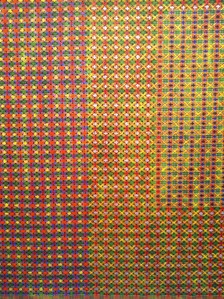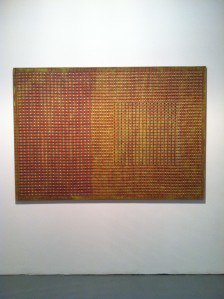Dubuffet & The Art Brut @ Ricco Maresca Gallery
Dubuffet’s drawings look good naked. In this one, a classic in the Frenchman’s canon, the impact of the ink on the paper registers with the fierceness of a snapped tree trunk. It’s a totally flat image, manic tangles contained in a body mostly defined by its chunky outline. It reminds me of an animal hide rug, but it could also be an illustration of psychotic depression. There’s no equivalence for the intensity and violence going on inside this woman’s body and that spooky grin Dubuffet gave her. In his first ever published piece, The Planet Trillaphon as it Stands in Relation to the Bad Thing, David Foster Wallace writes a passage that fits this drawing perfectly. This lady has what DFW called “the bad thing”…
“…I’ll tell what I think the Bad Thing is like. To me it’s like being completely, totally, utterly sick. I will try to explain what I mean. Imagine feeling really sick to your stomach. Almost everyone has felt really sick to his or her stomach, so everyone knows what it’s like: it’s less than fun. OK. OK. But that feeling is localized: it’s more or less just your stomach. Imagine your whole body being sick like that: your feet. the big muscles in your legs, your collarbone, your head, your hair, everything, all just as sick as a fluey stomach. Then, If you can imagine that, please imagine it even more spread out and total. Imagine that every cell in your body, every single cell in your body is as sick as that nauseated stomach.”
Dan Graham and Cory McCorkle @ Murray Guy
McCorckle’s sculpture and film look good naked, Graham’s schematic drawings, pictures, and architectural model don’t. The gallery is divided in half, McCorckle’s side is darkened for one wall sized projection of a man walking through a forest and a pair of long and skinny sculptures suspended form the ceiling. The film’s soundtrack of crackling, breezing, brushing, woodsy-noises are the final touch on an atmosphere that sooths and touches on the familiar Romanticism of man in nature, existentially alone yet part of something infinite.
Graham’s side looks like a plan for urban design, atriums especially, and one can see the curatorial hand here: a yin yang setup where Graham’s side is nature in man’s world vs McCorkle’s man in nature. No question Graham had some particularly insightful thoughts regarding privately owned public spaces, but they’re not evident in the drawings, photos, and 3-d mock up on display. If he were submitting this caliber work to Mom P.S.1’s annual contest for young architects, I’d be surprised if he raised a single eyebrow, unless there was some sickeningly clever statement to go with it, which knowing Graham you can’t rule out.
Ding Yi, Ai Wei Wei, and Wang Xingwei @ Chambers Fine Art
Black and white photos Ai Wei Wei snapped back in the eighties when he lived in New York look OK naked. These are essentially documentary shots, ephemera really, and a very small sample at that. (They’re drawn from a much larger collection I saw in Beijing years ago, put together by the super thoughtful young scholar Steph Tung.) Wei Wei takes a ton of photographs—still to this day—that have helped shape his story as a controversy-courting artist. The coolest photo may have been Wei Wei sitting on a bar stool beside Ginsberg. It’s funny to think, Ginsberg would never have become the household name he became were it not for the widely publicized court proceedings that decided his greatest poem, Howl, wasn’t pornography. Much later, obviously, it would be scandal and controversy that would make Wei Wei’s reputation go global. Yet here they are, a pair of radicals, hands cupped as if in meditation like a couple of Buddhists at the bar.
Xingwei’s paintings don’t look good naked, but Ding Yi’s do. Xingwei paints cityscapes on large corrugated sheets of metal. It all looks too planned to me, like a made to order object. The concept of a painting of the city on a piece of the city does nothing to enhance it. It feels more like an exercise than anything else.
And yet, Ding Yi’s painting is precisely an exercise, a practice, but it has the kind of pregnant potency and durational energy you find in canvases worked by Anges Martin, Johnnie Wionna Ross, or Shen Chen. His lines and dots are clear and concise; his colors and patterns pronounced and persistent. It looks effortless and masterful and meditative, and it’s painted on a checkered flannel sheet. Odd. Reminds me of warmth and warmth reminds me of Beuys, even though he never used flannels. Ding Yi’s paintings conform to no time, they’ll look good in ages beyond information.
On Kawara @ David Zwirner
When they occupy a large gallery, On Kawara’s date paintings look good naked. They’re around 100 of them on the walls at Zwirner’s, all different sizes, mostly grey with white lettering, though a few are blue or red. That’s his thing, everybody knows him for it, and so really presentation is what keeps the work fresh, well, that and whatever happens to be occurring in the world when these paintings get wall time. Coincidentally the debate raging among clock keeps now is that leap second coming up at the end of February. Got to keep the astronomical and atomic times in line. On Kawara paintings speak to both, but also to the human experience of time. What does time feel like? Well, nothing I suppose, it’s only a concept after all, nothing sensory about it. But it sure as hell can make you feel something: old or young or fast or slow. Here’s the On Kawara riddle that I came up with looking at his canvases. What makes you feel anxious when your behind it and easy when your ahead of it? (answer: Time)




